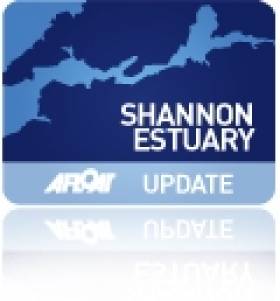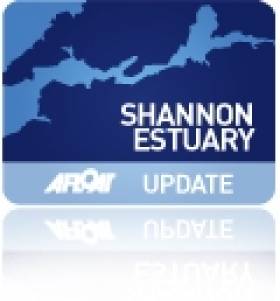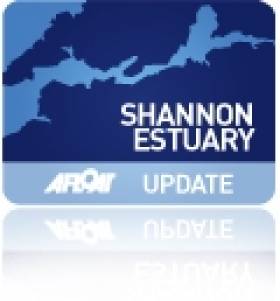Displaying items by tag: Foynes Flying Boat Maritime Museum
New Maritime Museum in Foynes Officially Opened by Tourism Minister
#NEWmaritimeMuseum – Foynes Flying Boat & Maritime Museum welcomed Michael Ring TD, Minister of Tourism & Sport who officially opened yesterday the mid-west tourist attraction's new maritime museum.
Minister Ring said "This new Maritime Museum adds greatly to the overall Foynes Flying Boat Museum, and will attract repeat visitors as well as many maritime enthusiasts, keeping Foynes at the forefront of tourism in the Shannon Region and on the new Wild Atlantic Way.
"I am pleased that the Government, through Fáilte Ireland, has provided support to this very worthwhile project under the Tourism Capital Investment Programme.
"I know that the development of a Maritime Museum, that would tell the story of the River Shannon and the influence on the lives of those communities living nearby, has always been a goal of the Museum's management here at Foynes. This ambition has now been realised".
The new maritime section tells the story of one of Ireland's great maritime assets... the River Shannon. The exhibits on display detail the geology, personality and mythology of the estuary stretching from Limerick docks down to Loop Head, marking the mouth of the Shannon at its seaward limits.
As previously reported the diversity of topics on display in the new maritime museum is a combination of interactive technology, artefacts, replica exhibits, and a stunning view of Foynes from the recently reinstated control tower that was used for the trans-Atlantic flying boats.
The tower has a balcony (equipped with bino-cularscopes) where shipping activity can be directly observed from and inside the tower and from where there is a photo-montage outlining the various landmarks of the village and estuary.
The view overlooking Foynes includes Foynes Yacht Club, Foynes Island and in the far distance across the estuary is the Aughinish Alumina processing plant.
During yesterday's opening ceremony, the dry-bulker Foxtrot could be seen at a Port of Foynes berth directly opposite from the observation tower and where cargo was been loaded on board.
Shannon Foynes Port Company (SFPC) earlier this year launched the master plan vision to 2041, which looks forward to the future and the museum is doing its part to preserve the past for the future.
The new addition to the award-winning Flying Boat Museum completes the overall plan that was first envisaged back in 1987 when a small group of interested people got together to look at the possibility of establishing a Flying Boat Museum in the Co. Limerick village.
Failte Ireland partly funded the new museum under their National Development Plan 2007 – 2013 programme which in this phase totalled €1.5m in which 75% was funded from Failte Ireland. The remaining funding where met through the museum's own resources and with financial assistance from Limerick County & City Council.
This now brings the total investment in Foynes Museum to €4.5m over the past twenty five years. The centre supports 16 employees and this season has attracted 40,000 visitors. For the second time the museum has been given a Silver Award for best visitor attraction by CIE Tours in 2012.
This year the museum achieved a Certificate of Excellence from Tripadvisor and has featured in many TV holiday shows and documentaries both at home and overseas.
In 2014 the museum is to feature in BBC Getaways, the TV3 Documentary "The Island" and a documentary on Ireland's role in aviation to be screened on RTE and to go on general release.
New Maritime Museum in Foynes to be Officially Opened
#NEWMaritimeMuseum - Minister of State at Department of Tourism & Sport, Michael Ring TD, will attend the Foynes Flying Boat & Maritime Museum on Tuesday 24 September to perform the official opening of the new maritime museum.
As previously reported on Afloat.ie the new maritime section which opened earlier this year,tells the story of one of Ireland's great maritime assets... the River Shannon. The exhibits on display detail the geology, personality and mythology of the estuary stretching from Limerick docks down to Loop Head, marking the mouth of the Shannon at its seaward limits.
The diversity of topics on display includes:
• Navigational charts and maps of the river including stories about pilots who raced their rowing boats to vessels, to be the first to guide the ships along Europe's largest navigable estuary
• The geoglogy, tides, weather and leisure on the Shannon
• The story of transportation and emigration on the river including the manufacture and export of confederate uniforms shipped from the Tait factory based Limerick through the federal blockade of southern ports during the 1860s.
• Development of Foynes harbour throughout the centuries including the type of cargo unloaded and the influence of the local gentry on Foynes and its inhabitants
• Different types of ships and boats used on the river including a replica wooden frame model of a canvas currack, very common in the Shannon region during the 1800s
• The story of transportation and emigration on the river including the manufacture and export of confederate uniforms shipped from the Tait factory based Limerick through the federal blockade of southern ports during the 1860s.
All of these stories and many more are on display with a combination of interactive technology, artefacts, replica exhibits, and a stunning view of Foynes from the recently reinstated Control Tower.
The Shannon Foynes Port Company recently launched the company's master plan vision up until 2041, which looks forward to the future and the museum is doing its part to preserve the past for the future.
This new addition to the award winning Flying Boat Museum completes the overall plan that was first envisaged back in 1987 when a small group of interested people got together to look at the possibility of establishing a Flying Boat Museum in Foynes.
The new museum was part funded by Failte Ireland under their National Development Plan 2007 – 2013 programme. Total investment in this phase was €1.5M –75% funded from Failte Ireland. Remainder was funded through Museum's own resources and with financial assistance from Limerick County & City Council.
This now brings the total investment in Foynes Museum to €4.5m over the past twenty five years. Sixteen jobs are supported and 40,000 visitors will have passed through the Museum this season. The Museum has achieved the 2013 Certificate of Excellence from Tripadvisor and features in many TV holiday shows and documentaries both at home and overseas. (2014 it will feature in BBC Getaways, TV3 Documentary "The Island" and a Documentary on Ireland's role in aviation which is to be screened on RTE and go on general release).
For the second time it has been given a Silver Award for best visitor attraction by CIE Tours in 2012.
The O'Regans Restaurant,named after the great Brendan O'Regan, offers snacks and light lunch and has become a favourite meeting spot for both visitors and locals alike.
Foynes also boasts a new playground and beautiful wooded walks developed by Coillte along the banks of the river.
The village is proud to have been nominated by Limerick County & City Council for this year's Pride of Place Competition and this season welcomed a pair of cruise ships.
#NewMaritimeMuseum – As previously reported, Shannon Foynes Port Company's master plan 'Vision 2041' looks forward to the future and soon the past will be explored when a new maritime museum opens next month, writes Jehan Ashmore.
It was at the launch of the masterplan at the Foynes Flying Boat Maritime Museum, where the new museum (opening 14 March) will be incorporated, to trace the rich history of the Shannon Estuary.
As the largest 'navigable' estuary (500km2) in Ireland and one of the deepest waterways in Europe, the museum will not just focus on shipping, but also the geology, personality and mythology of the estuary stretching from Limerick Docks down to Loop Head, marking the mouth of Shannon.
As previously reported, vessels such as the 82,562dwt London 2012, a dry bulk-carrier (Length: 229m X Beam: 32m X Draft: 14m) had docked at the Aughinish Alumina jetty last month.The port, which is Ireland largest bulk port company can handle larger vessels up to 200,000dwt, however under Vision 2041, the Shannon estuary is to cater for the World's largest container ships as the port is strategically located as a potential hub-port in Western Europe and creation of a 'Ocean Energy Hub'.
Its prime position is to take advantage of the new 'post-Panamax' sized super container ships and tankers under construction following the completion of the enlarged Central American canal linking the huge Asian market, notably from China and or via North America and onwards to Europe.
As these developments look to the future prospects of the estuary's ports, the past will not be forgotten as the flying boat museum with its replica aircraft based in Foynes, will have a new floor dedicated to exhibits. The diversity of topics on display in the maritime museum are listed below.
• The charts and maps of the river from the time of Ptolemy.
• The geology, tides and weather of the Shannon
• The pilots who raced in their rowing boats to be the first to guide large sailing ships up the estuary
• The dockworkers loading and unloading a vast range of cargo from ocean-going ships
• The "Spring-Rice Set" —the O'Briens, De Veres and Spring Rices, who owned large tracts of land on the shores of the river but who were actively concerned in the welfare of the less fortunate people around them
• The amazing record of ships on the river left to us by Murrogh O'Brien in the form of paintings and charts
• Different types of ships and boats used on the river
• The development of Foynes Port
• Navigation of the river including the many lighthouses that guided mariners up the river
• The tragic story of the Colleen Bawn
• The story of Transportation and emigration on the river.
• Tait's manufacture and export of uniforms to the American confederates during the Civil War.
• Display with Met Maps and audio visual on weather conditions.
• Story of the Windsor Castle Ghost Ship, sailed up the Shannon in 1843.
• Audio Visual on life on the River Shannon.
The maritime museum will be opened to the public from 14 March, 9am-5pm (visitors should try and arrive an hour before closing). For further details visit: www.flyingboatmuseum.com/
































































